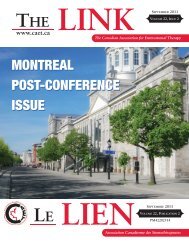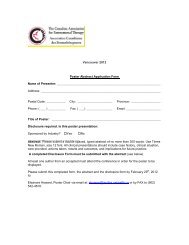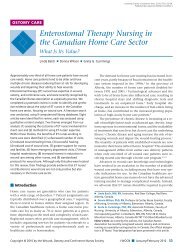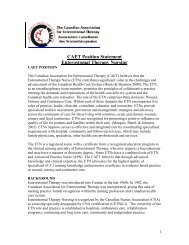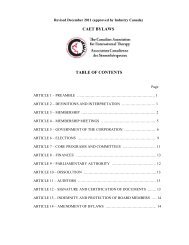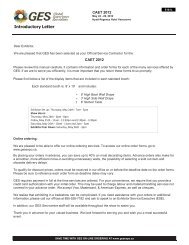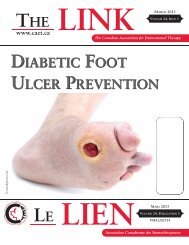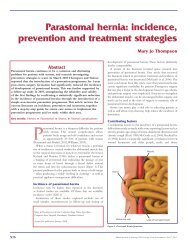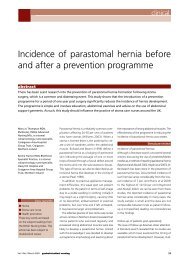Prevention of parastomal hernia: a comparison of results 3 years on
Prevention of parastomal hernia: a comparison of results 3 years on
Prevention of parastomal hernia: a comparison of results 3 years on
Create successful ePaper yourself
Turn your PDF publications into a flip-book with our unique Google optimized e-Paper software.
clinical<br />
studies included small samples and inc<strong>on</strong>sistencies<br />
in follow-up and documentati<strong>on</strong> <str<strong>on</strong>g>of</str<strong>on</strong>g> the time <str<strong>on</strong>g>of</str<strong>on</strong>g><br />
development <str<strong>on</strong>g>of</str<strong>on</strong>g> <str<strong>on</strong>g>parastomal</str<strong>on</strong>g> <str<strong>on</strong>g>hernia</str<strong>on</strong>g>, all <str<strong>on</strong>g>of</str<strong>on</strong>g> which<br />
hinder <str<strong>on</strong>g>comparis<strong>on</strong></str<strong>on</strong>g> <str<strong>on</strong>g>of</str<strong>on</strong>g> <str<strong>on</strong>g>results</str<strong>on</strong>g>.<br />
Follow-up <str<strong>on</strong>g>of</str<strong>on</strong>g> stoma patients postoperatively is<br />
poorly documented with regard to the time <str<strong>on</strong>g>of</str<strong>on</strong>g><br />
development <str<strong>on</strong>g>of</str<strong>on</strong>g> <str<strong>on</strong>g>parastomal</str<strong>on</strong>g> <str<strong>on</strong>g>hernia</str<strong>on</strong>g>s. Akman (1962)<br />
reported that 67.8% <str<strong>on</strong>g>of</str<strong>on</strong>g> incisi<strong>on</strong>al <str<strong>on</strong>g>hernia</str<strong>on</strong>g>s (n=500)<br />
had developed within 1 year postoperatively.<br />
Bucknall et al (1982) found that 57% <str<strong>on</strong>g>of</str<strong>on</strong>g> abdominal<br />
incisi<strong>on</strong>al <str<strong>on</strong>g>hernia</str<strong>on</strong>g>s (n=84) had developed within<br />
3 m<strong>on</strong>ths surgery.<br />
Factors c<strong>on</strong>tributing to the development <str<strong>on</strong>g>of</str<strong>on</strong>g><br />
<str<strong>on</strong>g>parastomal</str<strong>on</strong>g> <str<strong>on</strong>g>hernia</str<strong>on</strong>g> reported in the literature are<br />
obesity, sex, age, site <str<strong>on</strong>g>of</str<strong>on</strong>g> the stoma, abdominal<br />
distensi<strong>on</strong> and chr<strong>on</strong>ic cough (Pearl, 1989;<br />
McGrath et al, 2006). The variables examined<br />
in this study differ. Bucknall and Ellis (1984)<br />
reported the c<strong>on</strong>tributing factors to be chest<br />
infecti<strong>on</strong>, wound sepsis, male sex and age 60+<br />
<str<strong>on</strong>g>years</str<strong>on</strong>g>. Bucknall et al (1982) found a statistically<br />
significant correlati<strong>on</strong> between wound <str<strong>on</strong>g>hernia</str<strong>on</strong>g>ti<strong>on</strong><br />
Figure 1. Abdominal exercises following stoma-forming surgery. (Reprinted with<br />
kind permissi<strong>on</strong> from Resp<strong>on</strong>d Plus)<br />
and the elderly, male sex and obese patients<br />
undergoing bowel surgery.<br />
Aim <str<strong>on</strong>g>of</str<strong>on</strong>g> the study<br />
The aim <str<strong>on</strong>g>of</str<strong>on</strong>g> this follow-up study was to ascertain<br />
the reliability <str<strong>on</strong>g>of</str<strong>on</strong>g> the preventi<strong>on</strong> programme carried<br />
out by Thomps<strong>on</strong> and Trainor (2005). Raised<br />
awareness <str<strong>on</strong>g>of</str<strong>on</strong>g> the potential for <str<strong>on</strong>g>parastomal</str<strong>on</strong>g> <str<strong>on</strong>g>hernia</str<strong>on</strong>g><br />
development, the introducti<strong>on</strong> and teaching <str<strong>on</strong>g>of</str<strong>on</strong>g><br />
abdominal exercises and advice to use support<br />
belts while undertaking heavy lifting or heavy<br />
work until 1 year post-surgery were assessed to<br />
ascertain their c<strong>on</strong>tinued effectiveness in minimizing<br />
the development <str<strong>on</strong>g>of</str<strong>on</strong>g> <str<strong>on</strong>g>parastomal</str<strong>on</strong>g> <str<strong>on</strong>g>hernia</str<strong>on</strong>g>.<br />
Method<br />
The follow-up analysis utilized year 1 data as<br />
the c<strong>on</strong>trol for <str<strong>on</strong>g>comparis<strong>on</strong></str<strong>on</strong>g> <str<strong>on</strong>g>of</str<strong>on</strong>g> the effectiveness<br />
<str<strong>on</strong>g>of</str<strong>on</strong>g> the programme as it was in the initial study<br />
(March 2005):<br />
Year 1: A retrospective study <str<strong>on</strong>g>of</str<strong>on</strong>g> patients who<br />
had a new stoma formed between August 2001<br />
and July 2002 to determine the incidence <str<strong>on</strong>g>of</str<strong>on</strong>g><br />
<str<strong>on</strong>g>parastomal</str<strong>on</strong>g> <str<strong>on</strong>g>hernia</str<strong>on</strong>g> formati<strong>on</strong>.<br />
Year 2: A prospective study <str<strong>on</strong>g>of</str<strong>on</strong>g> patients who<br />
had a new stoma formed between August 2002<br />
and July 2003 to determine the incidence <str<strong>on</strong>g>of</str<strong>on</strong>g><br />
<str<strong>on</strong>g>parastomal</str<strong>on</strong>g> <str<strong>on</strong>g>hernia</str<strong>on</strong>g> formati<strong>on</strong>. These patients<br />
received active educati<strong>on</strong> <strong>on</strong> abdominal exercises<br />
(Figure 1) and were encouraged to use support<br />
belts or girdles to minimize the risk <str<strong>on</strong>g>of</str<strong>on</strong>g> developing<br />
a <str<strong>on</strong>g>parastomal</str<strong>on</strong>g> <str<strong>on</strong>g>hernia</str<strong>on</strong>g>.<br />
Year 3: A prospective study <str<strong>on</strong>g>of</str<strong>on</strong>g> patients who<br />
had a new stoma formed between August 2003<br />
and July 2004 to determine the incidence <str<strong>on</strong>g>of</str<strong>on</strong>g><br />
<str<strong>on</strong>g>parastomal</str<strong>on</strong>g> <str<strong>on</strong>g>hernia</str<strong>on</strong>g> formati<strong>on</strong>. These patients<br />
received active educati<strong>on</strong> <strong>on</strong> abdominal exercises<br />
(Figure 1) and were encouraged to use support<br />
belts or girdles to minimize the risk <str<strong>on</strong>g>of</str<strong>on</strong>g> developing<br />
a <str<strong>on</strong>g>parastomal</str<strong>on</strong>g> <str<strong>on</strong>g>hernia</str<strong>on</strong>g>. This arm <str<strong>on</strong>g>of</str<strong>on</strong>g> the study<br />
was utilized to test the reliability <str<strong>on</strong>g>of</str<strong>on</strong>g> the <str<strong>on</strong>g>results</str<strong>on</strong>g><br />
obtained in year 2. Follow-up was carried out<br />
for <strong>on</strong>e year post-surgery.<br />
As in the initial study, c<strong>on</strong>venience sampling was<br />
used to facilitate the capture <str<strong>on</strong>g>of</str<strong>on</strong>g> all patients who<br />
underwent surgery for stoma formati<strong>on</strong> at the<br />
two centres involved in the study. This method <str<strong>on</strong>g>of</str<strong>on</strong>g><br />
sampling enabled the maximum number <str<strong>on</strong>g>of</str<strong>on</strong>g> patients<br />
possible to be recruited during the proposed<br />
timescale. Within year 1 (August 2001 to July<br />
24 gastrointestinal nursing vol 5 no 3 April 2007



